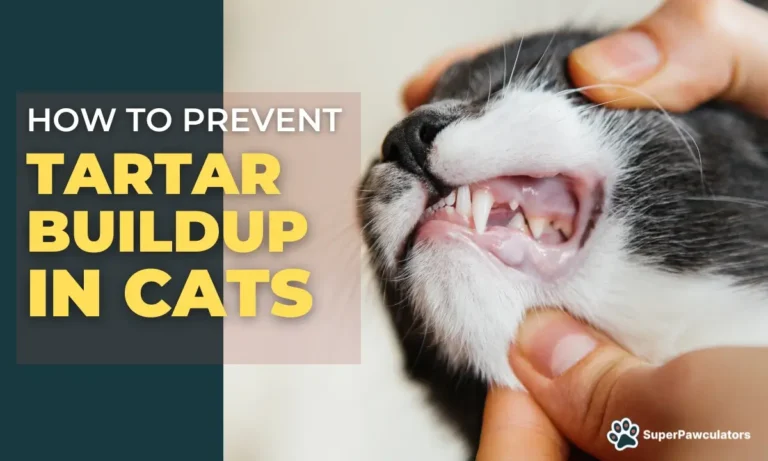To help us create more feline tools and guides, this site contains affiliate links, which may earn us a small commission at no extra cost to you.
Keeping your cat’s teeth clean is just as important as providing them with a balanced diet. Tartar buildup, the hardened plaque on your cat’s teeth can lead to more than just bad breath. It’s often the starting point for gum disease, tooth loss, and even systemic infections that can affect vital organs like the heart, liver, and kidneys.
Unlike dogs, cats are meticulous groomers, but dental hygiene isn’t part of their routine. Plaque, a sticky film made of bacteria and food particles, accumulates on teeth and hardens into tartar. This buildup can irritate gums, cause inflammation (gingivitis), and eventually progress to painful periodontal disease if left untreated.
Many cat parents overlook subtle signs of dental trouble, such as drooling, difficulty eating, or yellowish buildup on teeth. However, addressing tartar early can prevent these issues and keep your cat happy and healthy.
Did You Know? According to the Cornell Feline Health Center, between 50 to 90% of cats over the age of three show signs of dental disease.
Understanding the Causes of Tartar Buildup
Tartar doesn’t appear overnight. It forms gradually due to several factors, making it essential to understand its causes for effective prevention.
- How Tartar Forms: Plaque builds up when saliva, food particles, and bacteria stick to the teeth. If not removed, it hardens into tartar, creating a rough surface that encourages further bacterial growth.
- Diet and Tartar: Wet food, while nutritious, tends to stick to teeth more than dry kibble. Dry food can help scrape away some plaque naturally, but it’s not a substitute for proper dental care.
- Other Risk Factors:
- Age: Older cats are more prone to tartar buildup.
- Breed: Flat-faced breeds like Persians and Siamese may be predisposed to dental problems due to their jaw structure.
- Lack of Dental Care: Without brushing or professional cleanings, plaque and tartar can accumulate unchecked.
Signs to Watch For: Yellow or brown buildup on teeth, bad breath, swollen gums, drooling, or pawing at the mouth may indicate tartar buildup.
Daily and Weekly Preventative Measures
Preventing tartar is easier (and less expensive) than treating advanced dental issues. Here are actionable steps you can take:
- Brushing Your Cat’s Teeth Brushing is the gold standard for tartar prevention. It may seem challenging, but with patience, it’s achievable.
- Use a cat-specific toothbrush or a finger brush.
- Opt for flavored toothpaste (e.g., chicken or fish) designed for cats.
- Brush in small circles, focusing on the gum line.
- Start slow and reward your cat with treats or cuddles afterward.
- Dental Treats and Chews Dental treats and chews are excellent for reducing plaque while satisfying your cat’s urge to chew. Look for products approved by the Veterinary Oral Health Council (VOHC).
- Water Additives and Oral Gels For cats who resist brushing, water additives or oral gels can help reduce bacteria and plaque. Simply add drops to their water or apply gels directly to their teeth.
- Diet Adjustments
- Include dental-friendly dry food designed to scrape away plaque.
- Avoid sticky wet food that clings to teeth.
- Chew Toys Cat-safe chew toys can naturally clean teeth while keeping your feline entertained. Choose non-toxic, durable materials.
Quick Tip: Combining brushing with dental treats and oral care products significantly improves tartar prevention, as noted by the American Animal Hospital Association (AAHA).
Professional Veterinary Care
While at-home care is essential, regular vet visits ensure thorough cleaning and early detection of dental issues.
- Routine Checkups: Your vet will inspect your cat’s mouth for tartar, gum inflammation, or signs of dental disease.
- Professional Cleanings: Under anesthesia, your vet will remove tartar, polish teeth, and address any dental problems like extractions or deep gum cleaning.
- When to Seek Immediate Care:
- Persistent bad breath.
- Drooling or difficulty eating.
- Swollen or bleeding gums.
- Pawing at the mouth or unusual vocalizations.
Did You Know? The ASPCA recommends annual dental cleanings for most cats, especially seniors or those prone to dental issues.
Maintaining your cat’s oral health doesn’t require perfection—just consistency. Regular brushing, the use of dental treats, and professional checkups create a comprehensive dental care routine.
- Key Takeaways:
- Tartar forms when plaque isn’t removed and can lead to serious health problems if ignored.
- Daily brushing, along with dental-friendly products, helps prevent tartar.
- Annual vet visits and professional cleanings ensure optimal oral health.
By staying proactive, you’ll ensure your cat enjoys a lifetime of purrs, cuddles, and a bright, pain-free smile. After all, a healthy mouth means a happy cat!
What causes tartar buildup in cats?
Tartar forms when plaque, a film of bacteria on the teeth, hardens over time. This happens due to insufficient oral hygiene and can lead to dental problems like gingivitis and periodontal disease.
How can I prevent tartar buildup in my cat?
Prevent tartar by brushing your cat’s teeth with cat-specific toothpaste, using dental treats, feeding diets designed for dental health, and scheduling professional cleanings with your veterinarian.
Are there specific diets to reduce tartar in cats?
Yes, dental diets are formulated to reduce plaque and tartar. These foods often have a specific texture that encourages chewing and contain nutrients that prevent tartar buildup.
How often should I brush my cat’s teeth?
Brushing daily is ideal, but if that’s not possible, aim for at least 3-4 times a week to effectively reduce plaque before it hardens into tartar.
What are signs of tartar buildup or dental issues in cats?
Look for signs like bad breath, yellow or brown buildup on teeth, red gums, drooling, or difficulty eating. These indicate dental problems that need a vet’s attention.

